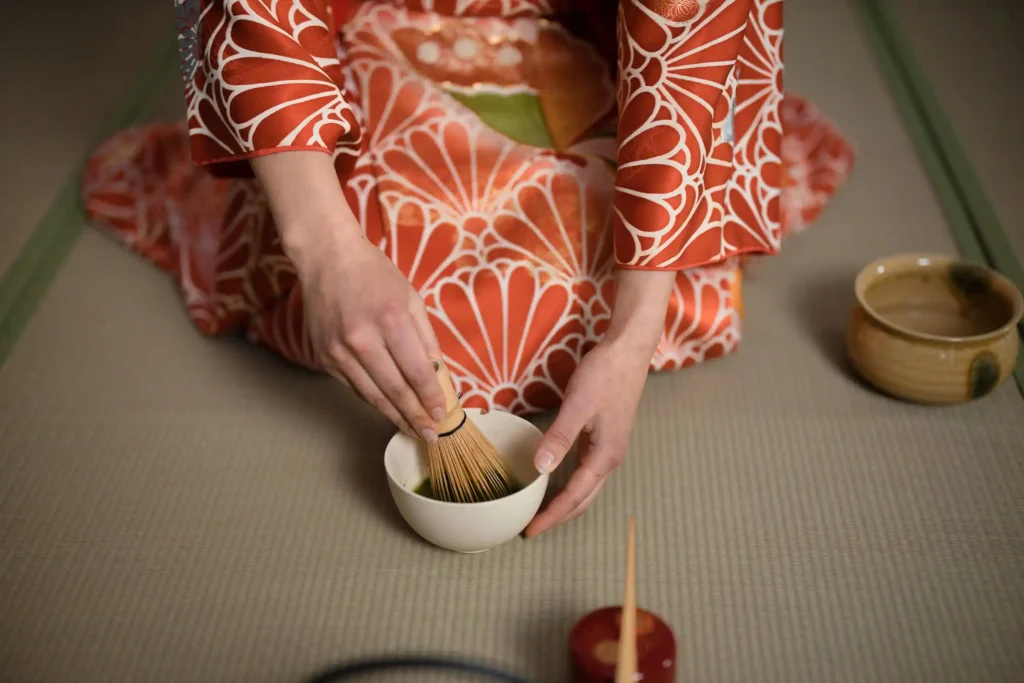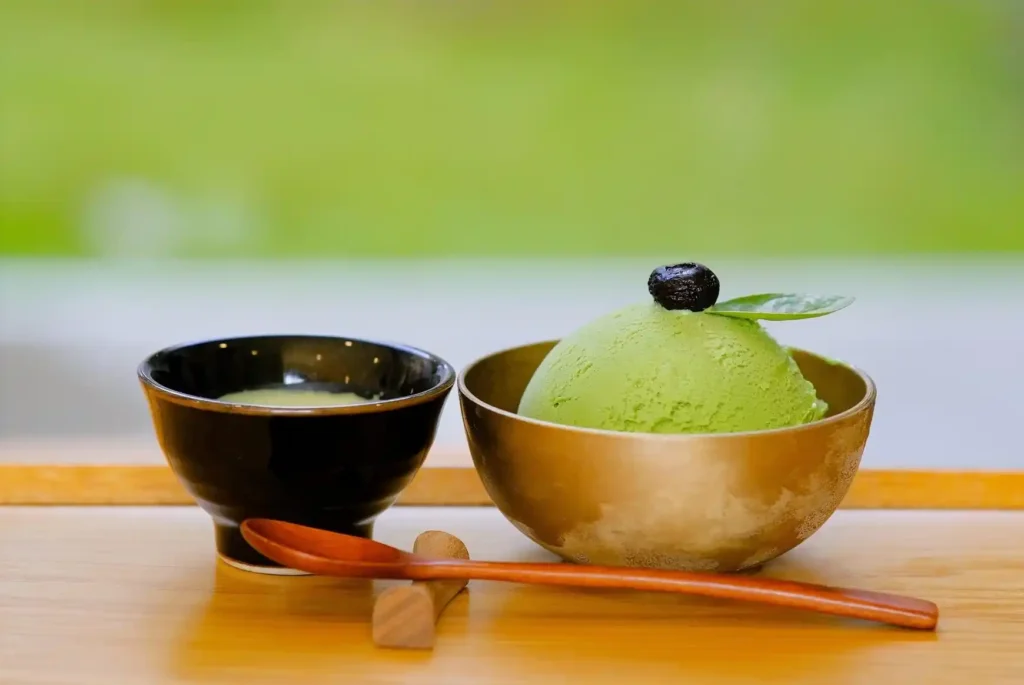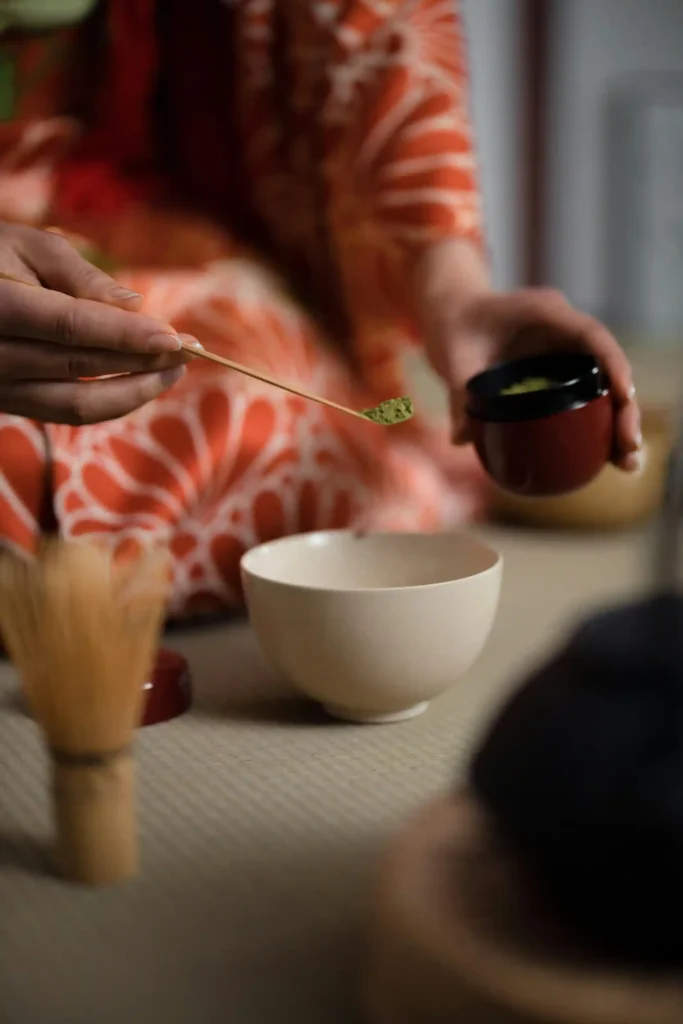
Matcha tea (抹茶) has become a worldwide sensation, but few truly know its fascinating history and ancient tradition. If you’re planning a trip to Japan or simply want to discover this culinary treasure, this guide will walk you through everything you need to know about matcha tea.
What is matcha tea and what is its history?

Matcha (抹茶) is a finely powdered green tea obtained by grinding shade-grown tea leaves. Its name literally means “ground tea” and represents one of Japan’s most refined traditions.
In the 9th century during the Tang Dynasty, Chinese Buddhist monks were already grinding tea powder (mó chá), but it wasn’t exactly like today’s matcha. Its history in Japan dates back to the 12th century, when the Buddhist monk Eisai (栄西) brought the first tea seeds from China. However, it was in the 16th century that tea master Sen no Rikyū (千利休) perfected the tea ceremony, or chanoyu (茶の湯), elevating matcha to an art form.
During the Edo period, matcha consumption spread among the samurai class and later among the general population, although high-quality matcha remained exclusively for Japan’s elite.
Today, matcha is a symbol of Japanese culture and a world culinary heritage.
The Geographical Origin of the Best Matcha
The finest matcha teas come from specific regions of Japan, each with unique characteristics:
Uji (宇治), in Kyoto Prefecture, is considered the birthplace of the highest quality matcha. Its centuries-old plantations and traditional techniques produce the most prized matcha in the world. Uji produces the highest-quality ceremonial matcha, with varieties such as Tenshin (天心) and Unjō (雲上).
Yame (八女, Fukuoka) is less well-known internationally, but rivals Uji in ceremonial quality. Yame matcha uses longer shading techniques, giving it a sweeter flavor.
Nishio (西尾) in Aichi is the region with the highest matcha production in Japan, known for its consistency and commercial quality. It is primarily intended for culinary use.
Shizuoka (静岡) offers more affordable varieties without sacrificing flavor, ideal for those new to the world of matcha. It is not among the finest, but it is great for cooking and blending.
The temperate climate, controlled humidity, and mineral-rich soils of these regions create the perfect conditions for growing tencha (碾茶), the leaf that becomes matcha.

Traditional Matcha Preparation and Consumption
Matcha preparation is a ritual that requires specific tools:
Essential Tools:
- Chawan (茶碗): Ceramic tea bowl, preferably unglazed to maintain the temperature.
- Chasen (茶筅): Bamboo whisk. It should have 80 to 100 prongs for usucha (a lighter matcha preparation) and 60 to 70 prongs for koicha (a more concentrated matcha preparation).
- Chashaku (茶杓): Bamboo scoop, the traditional measure is approximately one gram.
Step-by-step preparation:
There are two main styles:
- Usucha (薄茶): light tea, more common today
- Koicha (濃茶): thick tea, reserved for formal ceremonies
Exact temperature and proportions:
| Type | Matcha (g) | Water (ml) | Temp. (°C) | Whisking time |
|---|---|---|---|---|
| Usucha | 1.5-2 | 60-70 | 70-80 | 15-20 seconds |
| Koicha | 3-4 | 30-40 | 60-70 | Mix (do not whisk) |
Matcha is consumed directly from the chawan, appreciating its vibrant green color, vegetal aroma, and characteristic umami flavor.
Nutritional Properties and Benefits of Matcha

Matcha concentrates all the nutrients of the tea leaf, offering exceptional benefits (according to studies from 2020 to 2023):
Antioxidants:
EGCG (epigallocatechin gallate): 70-100 mg per cup (vs. 5-10 mg in brewed green tea).
ORAC (antioxidant capacity): 1,300-1,600 units per gram (similar to blueberries).
Caffeine: 35-70 mg per cup (vs. 95 mg in coffee), with a prolonged effect due to L-theanine. Unlike coffee, the caffeine in matcha is released slowly, avoiding sudden energy peaks and drops.
Chlorophyll: 5-10 mg/g (higher if the tea is shade-grown for more than 20 days). Chlorophyll helps eliminate heavy metals and chemicals from the body.
High in antioxidants: A cup of matcha contains 137 times more catechins than regular green tea, especially EGCG (epigallocatechin gallate).
L-theanine for focus: This unique amino acid provides mental calm and relaxed alertness, explaining why monks used it for meditation.
Vitamins and minerals: Rich in vitamin C, vitamin A, potassium, iron, and dietary fiber.
Matcha vs. other Japanese teas: which one should you choose?
Each Japanese tea has its place in Japanese culture:
Matcha vs. Sencha (煎茶): Sencha is the most popular green tea in Japan, but matcha offers a higher concentration of nutrients when consumed as a whole leaf.
Matcha vs. Gyokuro (玉露): Both are shade-grown, but gyokuro is steeped while the matcha is blended. Matcha has a more intense flavor.
Matcha vs. Hojicha (ほうじ茶): Hojicha is a roasted green tea with a smoky flavor and less caffeine. Matcha maintains its pure herbal profile.
Matcha vs. Genmaicha (玄米茶): This blend of green tea with roasted rice is smoother. Matcha offers a more authentic and ceremonial experience.
Matcha stands out for its versatility: perfect for traditional ceremonies, but also ideal for lattes, desserts, and modern cuisine.
Practical Guide: How to Choose and Prepare the Best Matcha

How to Choose Quality Matcha
Matcha Grades:
- Ceremonial Grade: The finest, vibrant green color, smooth flavor
- Premium Grade: Medium-high quality, versatile for drinking and cooking
- Culinary Grade: Ideal for baking and lattes
Signs of Quality:
- Bright jade green color (not yellowish)
- Very fine, talcum-like texture
- Fresh, vegetal aroma
- Clearly specified origin
- Recent production date
Where to Buy Authentic Matcha
In Japan: Visit traditional shops in Uji, Kyoto, or department stores like Takashimaya and Mitsukoshi.
Online: Look for specialized importers that maintain the cold chain and offer certification of origin. You can look for these two certifications:
- JAS (Japanese: 日本農林規格): Guarantees Japanese origin.
- Organic JAS: It is organic as well as Japanese.
Local stores: Check that the matcha is refrigerated and in airtight containers.
How to store matcha tea according to Kyoto University:
- Use an airtight container, ideally glass or metal, avoid plastic.
- Keep away from light, moisture, and oxygen, zip-lock bag + vacuum pack.
- Maintain a temperature: 4-8°C, use the refrigerator if not consumed within the next month. Freeze only if vacuum-packed.
Tips for perfect preparation
Water temperature: 70-80°C is crucial. Above 85°C, matcha becomes bitter.
Stirring Technique: Quick, smooth, “M” or “W” motions, not circular.
Quantity: 1-2 grams per serving and 60-70ml of water; adjust according to your personal preference.
Serving Time: Consume immediately after preparation to preserve the best flavor and texture.
Where to Have the Best Matcha Experience in Japan
- Kyoto: Visit Taiho-an in Uji or the Philosopher’s Path, where tea houses serve matcha with wagashi sweets.
- Tokyo: Sakurai Japanese Tea Experience (in Omotesando) offers modern tastings with English explanations.
- Fukuoka: Try the rare Yame matcha at Kawabata Shotengai Market.
Ready for a matcha tea adventure in Japan?
Matcha isn’t just a drink; it’s a window into Japanese culture. From the plantations of Uji to the tea houses of Tokyo, every sip tells a story of tradition and perfection.
If you want to discover the secret temples where matcha originated, the finest plantations, and authentic ceremonies, our team can design a tailor-made trip. Because matcha isn’t just a drink… it’s the essence of Japan in a cup.
📩 Contact us and make your trip include an unforgettable matcha experience. 🍵✨
At Asiahop, we can help you design your perfect route through Japan’s most important tea-producing regions. Because traveling is about discovery, and matcha is just the beginning of your Japanese adventure.
Image credits: Mirko Stödter, Tran Thao An, Owen Carver from Pixabay. Cottonbro studio, Anh Nguyen from Pexels.